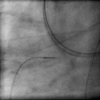Case presentation
The ostial CTO of the dominant RCA was approached bilaterally using 7F Guide systems. The CTO was visualized as an abrupt proximal cap, sizable distal vessel, >40mm length, bending inside, and heavily calcified, constituting a JCTO Score of 4 ( Video 1). The septal collateral crossing was achieved by a combination of Sion, Corsair Pro microcatheter (both, Asahi Intecc, Japan), and 2cc pure contrast injection highlighted the distal cap of the CTO ( Video 2).
Retrograde Fielder XT was advanced in a knuckle shape ( Figure 1), and further wiring was replaced by a Gaia 3 (Asahi Intecc, Japan), confirming a wiring position inside a vessel structure in RAO view ( Figure 2).
When the wire was exchanged to a stiffer one and advanced a while, the wire was found stuck inside the Corsair Pro ( Figure 3) but pull back and rotation enabled the whole retrograde system to be withdrawn to the middle segment. Before losing the ground, the retrograde system achieved, another system of a Fielder XT-R (Asahi Intecc, Aichi, Japan) over a Finecross microcatheter (150cm, Terumo, Tokyo, Japan) was advanced alongside the prior retrograde system, paying particular attention not rapping around the first system and reached to the distal RCA ( Figure 4).
After removing the first retrograde system, a new retrograde system crossed into the CTO. The system was replaced by a new Confianza Pro 12g and Corsair pro over a trapping technique, and the Confianza Pro directly crossed the occlusion and entered the antegrade 7F JR4.0 Guide ( Video 3). Retrograde entry of the Corsair Pro into the 7F JR4.0 allowed a Guidewire exchange to an RG3 330cm (Asahi Intecc, Japan). Over which balloon inflation, DES deployments, and hi-pressure NC balloon optimization was carried out successfully. An excellent flow was recovered at the end ( Video 4).
This demonstrates how to bail out the stagnant mode of retrograde approach, and to carry on a procedure without greatly setting back.








